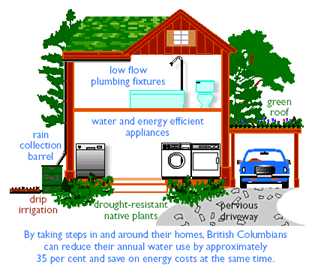British Columbians use much more water than they need to. Conserving water reduces our need for treated drinking water and wastewater treatment, as well as water infrastructure. Water conservation saves you and your community money and reduces our impact on the environment. This page has many easy and inexpensive ways you can be part of the solution.
Complete a home water assessment.
The Water Smart Home Assessment is an activity you can do with the whole family – kids will love being involved in measuring and timing! Compare your usual practices with those that are the most water smart, and identify steps to reduce your water usage and impact.
Saving Water Inside
Think water efficient next time you buy products like washing machines, dishwashers, fridges, irrigation systems, taps and toilets.
- Replace your toilet with a low-flow or dual flush model. A new “6 litre per flush” model will save you up to over 25,000 litres per year for a typical family. A dual flush model can save an average of ~26% more water than a 6 litre low flow toilet.
- Don’t use your toilet as a waste basket and remember you don’t have to flush every time!
- Shower under a low-flow showerhead (9 litres of water per minute). This will save up the average family up to 20,000 litres/year. You’ll also save money on your energy bill by heating much less water.
- Next time you have to replace your washing machine, look for a water efficient front loading model. These models also require less energy and save money in the long term.
- Even something as simple as turning off the tap when you brush your teeth or wash vegetables will save up to 20 litres a minute. This adds up to hundreds of litres a year.
- Leaks and dripping taps are an unnecessary waste of water. Even a small leak can add up to hundreds of litres a year.
Saving Water Outside
Garden watering is the biggest water use in the average home – often more than one-third of water use occurs outdoors. An average garden hose uses up to 20 litres per minute.
- Landscape using native or drought-resistant plants and garden designs that minimize water use.
- Watering twice a week for less than an hour should be more than enough. Most plants will thrive with far less water than we currently use.
- Collect rainwater for watering the garden. Water the roots of your plants, instead of the leaves, with an efficient method like drip irrigation.
- Watch the weather before watering the garden. If rain is predicted, let Mother Nature take care of the job for you. Avoid watering in windy or hot conditions, when the vast majority of water will be lost to evaporation.
- Another great way to save water is to use a broom to sweep driveways and paths instead of the garden hose. You get a great bit of exercise this way too.
- Apply a layer of mulch on your garden beds and leave the grass a little bit longer. You’ll save work by watering less frequently and mowing the lawn less often.
Ways to protect quality
- Share your smart water choices with friends and neighbours.
- Don’t throw chemicals or toxic solids down the sink, toilet or storm drains. They pollute the environment and cause bad water quality issues that are costly to fix.
- Buy low phosphate or phosphate free detergents – look at the labels at the store to work out which one is best for your needs.
- Use fertilizer and compost in the right quantity. Extra fertilizer runs off your garden when it rains and the extra growth that fertilizer promotes can negatively impact creeks, rivers and the ocean.
- Drive your car onto the grass when you are going to wash it and remember more soap and chemicals isn’t better!
- Check out www.waterbucket.ca or Go Blue for lots more tips and tools to save water at home, on the farm, at work and in your community.
- Make sure your actions don’t pollute or harm the environment. Reduce the use of hazardous products in your home and garden.
- Reduce or eliminate the use of fertilizers and pesticides. Avoid applying them close to a well
- Take paints, oils, batteries and other hazardous materials to the nearest recycling or collection facility
- Do not pour anything but water into storm sewer grates – these sewers flow directly into waterways
- If you are on a septic system, ensure that it is regularly maintained


